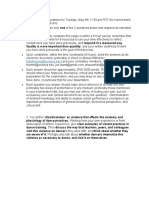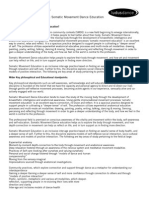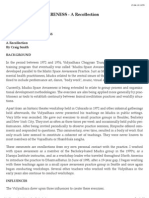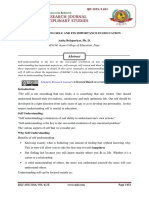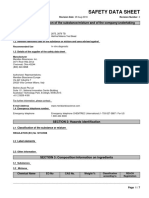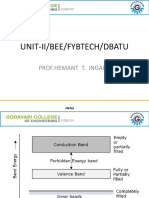Professional Documents
Culture Documents
A Study Between Body Image, Self-Efficacy and Perceived Stress Among Dancers in India
Copyright
Available Formats
Share this document
Did you find this document useful?
Is this content inappropriate?
Report this DocumentCopyright:
Available Formats
A Study Between Body Image, Self-Efficacy and Perceived Stress Among Dancers in India
Copyright:
Available Formats
Volume 8, Issue 5, May – 2023 International Journal of Innovative Science and Research Technology
ISSN No:-2456-2165
A Study between Body Image, Self-Efficacy and
Perceived Stress Among Dancers in India
V. Mukherjee1
Sampreeti Das2
Kristu Jayanti College MSc.Counselling Psychology
Abstract:-The study’s main aim was to find the gender With their dance performances, dancers tell tales and
differences between male and female dancers in self- communicate ideas. Dancers can move to a variety of
efficacy body image and perceived stress. It aims to also musical styles, including modern, ballet, and musical
indicate significant differences, if any, among the theatre, and they frequently perform as a group. Dancers can
different kinds of gender. Additionally, it studies the appear in ballets, dance performances, TV shows, and
impact of self-efficacy, perceived stress and body image movies.
issues amongst young adults. The study was conducted,
and an online survey was used to collect responses from Dancers receive a wide range of education and
60 adults. Body Image Avoidance Questionnaire (BIAQ), instruction, although they often complete many years of
Perceived Stress Scale (PSS) and General Self Efficacy professional training. The majority of dancers start their
scales were used to gather the data. Normality test was training while they are very young by enrolling in private
done and it was found that the data for perceived stress dancing lessons or training courses. By the age of 18, many
and self- efficacy wasn’t normally distributed and that dancers are already attending auditions and looking for
body image data was normally distributed. So work.
accordingly correlation, Mann Whitney’s test and t test
were used to analyze the data. Leading professional dance companies may choose
applicants for entry to their full-time training programs
I. INTRODUCTION while also offering intensive summer training programs.
Many dance genres like jazz, ballet, modern, and hip-hop
Dance is defined as the rhythmic movement of the are covered in the programs. Although a college degree is
body, generally to the accompaniment of music, in a specific not required, many dancers do pursue one because it gives
area, with the objective of expressing an idea or emotion or them the chance to explore new genres and participate in
just enjoying the moves. performances.
Dancing is a skill or talent , but the art of dance In order to be hired by a dance company, a dancer
enables dancers to use it as a means of profound self- would actively participate in as many auditions as possible.
expression leaving a deep impact on onlookers who don't They would spend a lot of time practising each day to learn
feel the urge to dance themselves. The two most significant the intricate dance moves that their audience would like. To
threads to be considered, are the two notions of the art of refine their routines, they practise new dances and
dance: dancing as an act borne out of freedom, collaborate closely with coaches, choreographers, and other
unconstrained and dance as a skillfully choreographed dancers.
performance which is more restricted. The two ideas seem
to overlap closely in dance and neither is possible without He or she may participate in photo shoots and attend
the other. production-related promotional events. In addition to the
customary live performances, some dancers also appear on
Although the above broad definition encompasses all the internet, in movies, on television, in amusement parks,
forms of the art, philosophers and critics have come up with on cruise ships, and in other venues including casinos. When
diverse definitions of dance throughout history, that are dancers age, they could decide to segue into teaching dance
essentially descriptions of the particular type of dance that in high schools or universities, or they might decide to
each writer was most familiar with. Therefore, the crucial pursue careers as directors or choreographers.
role that dance played in classical Greek theatre, where the
chorus making use of dance movements enacted the To stay in shape for their dance programs, dancers
dramatic themes during lyric interludes, is referenced when need to maintain their strength and engage in regular
Aristotle states in The Poetics that dance is rhythmic exercise. They frequently perform throughout the day in
movement whose purpose is "to represent men's characters addition to practising, so they don't have set working hours.
as well as what they do and suffer." Mackrell, J. R. (2023, Some dancers spend months at a time away while
March 31) performing in other cities. Due to the competitive nature of
the job market, many dancers reside in larger cities. Powers,
S. (2016, July 28)
IJISRT23MAY1359 www.ijisrt.com 1682
Volume 8, Issue 5, May – 2023 International Journal of Innovative Science and Research Technology
ISSN No:-2456-2165
II. BODY IMAGE objective. Self-efficacy is a trait that people exhibit in a
variety of contexts and domains, including relationships,
Your thoughts and feelings about your body constitute employment, and other crucial areas.
our body image. Positive and negative experiences related to
one's body image are common, and a person may experience Do you believe you can overcome challenges and
positive, negative, or mixed feelings based on that. Both achieve your objective, or do you give up in the face of
internal (such as personality) and external (such as social failure? Do you have self-doubt or are you like the tiny train
environment) elements have an impact on body image. engine from the beloved children's book, who exclaimed, "I
think I can, I think I can!" when faced with challenges? You
Mainly there are four aspects of body image which are probably have a high level of self-efficacy if you typically
as follows: persevere when faced with adversities.
Your perceptual body image is how you perceive your Self-efficacy is crucial since it determines how you
physical self. This is generally not an accurate perceive yourself and whether or not you succeed in
reflection of how you are perceived by others. reaching your life's objectives. Albert Bandura's social
Your emotional body image is the way you feel about cognitive theory, which emphasizes the function of
your physical appearance. Emotions can range from observational learning, social experience, and reciprocal
pride to self-loathing, but that mostly sums up how determinism in personality formation, is centred on the idea
satisfied or unsatisfied you are with your appearance, of self-efficacy.
weight, and specific body parts.
Your cognitive body image is how you perceive your Self-efficacy, in Bandura's view, is a component of the
physical appearance. This may cause an obsession with self-system, which also includes one's attitudes, capacities,
weight and body image. and cognitive talents. This system has a significant impact
Your behavioral body image refers to your actions on how we perceive and react to various events. A crucial
resulting from your body image. When a person is component of this self-system is self-efficacy.
dissatisfied with their looks, they may isolate
themselves or engage in unhealthy habits to improve it. Albert Bandura defined self-efficacy as "the
confidence in one's capacity to organise and carry out the
A person is said to have a good body image when they courses of action necessary to control potential events."
are able to accept, value, and respect their physique. This Self-efficacy is the conviction that one can succeed in a
needs to be distinguished from body satisfaction since you specific circumstance. These ideas influence how
might be unhappy with some features of your body yet be individuals think, act, and feel.
able to embrace it with all its flaws. A person is less likely
to develop an eating disorder if they have a positive body The topic has become one of the most researched in
image, which is one of the protective factors. psychology since Bandura's groundbreaking 1977 paper,
"Self-Efficacy: Toward a Unifying Theory of Behavioral
A Positive Body Image is Associated with: Change," was released. Why has psychologists and
Higher self-esteem, which determine how one thinks educators' interest in self-efficacy grown so much?
about oneself, can have an impact on various aspects of life
and enhance happiness and wellbeing. Self-efficacy can affect everything from psychological
states to behaviour to motivation, as Bandura and other
Self-acceptance helps a person to feel at ease and be researchers have shown.
content with the way they seem and this makes them less
susceptible to being influenced by unrealistic media images What objectives we pursue, how we carry them out,
and social expectations that one needs to look a certain way. and how we assess our own performance are all influenced
by self-efficacy.
When someone repeatedly has negative thoughts and
feelings about their body, it can lead to body dissatisfaction. How we think, act, and feel about our place in the
Though it is an internal emotional and cognitive process, world are all influenced by our self-belief in our capacity to
body dissatisfaction stems from outside forces like pressure succeed. Cherry, K. (2023)
to conform to an ideal. Those who are unhappy may take
recourse to improper weight-control methods, including IV. PERCEIVED STRESS
disordered eating. Consequently they are more likely to
develop an eating disorder . Lawler & MD, 2022 An individual's perception of their level of stress at a
certain point in time or over an extended period when
III. SELF EFFICACY expressed in feelings or thoughts is known as perceived
stress.
Self-efficacy is the confidence to carry out an activity
or accomplish a goal. It indicates ones self-assurance in Feelings about how unpredictable and uncontrollable
managing their conduct, having an impact on their life situations are, how frequently one needs to deal with
surroundings, and staying motivated in the pursuit of their problems, how much change is taking place in one's life, and
IJISRT23MAY1359 www.ijisrt.com 1683
Volume 8, Issue 5, May – 2023 International Journal of Innovative Science and Research Technology
ISSN No:-2456-2165
confidence in one's ability to handle challenges are all Another study which saw the relationship between the
factors in perceived stress. It measures how a person feels personality and stress among artists revealed that the stress
about life situations and their capacity to handle stress, was mainly induced due to the constant need to survive in
rather than the sort or frequency of such events that have the competitive world of art. The limitations of this study
occurred. were that it was conducted on a control group of artists
consisting of not just dancers but also actors, musicians and
People may experience similar traumatic situations, singers.
but they may judge their impact or severity differently
depending on their personality, coping mechanisms, and According to a study conducted in the University of
social support. Hence, perceived stress affects how a person Quebec at Montreal, which conducted the study on the topic
interacts with the environment—which is perceived as of Relationship between Passion and Injury on 81 students
threatening or overwhelming—in a way that will impact found that students with harmonious passion were more
their wellbeing (Lazarus & Folkman, 1984). Through the careful about their injury and they waited for their injuries to
use of a questionnaire like the Perceived Stress Scale, heal before they start dancing again and people with
perceived stress is frequently assessed as the frequency of Obsessive passion are more prone to not be careful about
these feelings (Cohen, Kamarck, & Mermelstein, 1983). their injuries which may result in prolonged injury or even
worse. This study did not talk anything about the gender
The relationship between stress and various ailments, differences, perceived stress, self efficacy and body image.
such as mental disorders, cancer, cardiovascular disease, Which gave more scope to go ahead with the current chosen
drug abuse, chronic diseases, etc. makes it a key reference topic. Rip, B., Fortin, S., & Vallerand, R. J. (2006).
point in health studies. Understanding stress across diverse
sociodemographic, cultural, and socioeconomic groups VI. METHOD
could help in preventing major health concerns stemming
from stress. The incidence of mental illnesses in Europe Research Design
demonstrates the significance of taking stress factors into The study followed a correlational design to assess the
account. relationship between self efficacy, body image and
perceived stress among male and female dancers. The study
Understanding how people perceive stress and manage mainly focused on analyzing the gender differences among
with it requires a grasp of cultural elements, particularly the the three variables and how it played a vital role in their
societal structure. This distinction demonstrates how the lives as professional dancers. The three variables were
impact of stress varies among European nations, including chosen to see whether body image came as a barrier for
the UK, Germany, France, the Netherlands, Spain, and dancers while performing, whether dance was used as a
Belgium (Cao et al., 2016). In order to quantify mechanism to overcome stress inducing factors and to find
psychological stress in health and disease globally, it is whether or not self efficacy helped dancers to attain their
crucial to assess how people experience stressful dance goals. (Tools used for analysis of the data).
circumstances in their life. This research is particularly
important for comprehending, preventing, and treating Statement of the Problem
numerous health issues that transcend national boundaries. The present study was undertaken to understand the
Vallejo, M. A., Vallejo-Slocker, L., Fernández-Abascal, E. relationship between body image, self efficacy and
G., & Mañanes, G. (2018). perceived stress among male and female dancers.
V. REVIEW OF LITERATURE Objectives
The previous studies included conducting a cross- To study if there is a relationship existing between
sectional study between 90 ballet schools with 156 controls body image, self efficacy and perceived stress among
to see how students perceive their body and whether or not male and female dancers.
they are satisfied with it. Studies showed that most To determine if there are any differences in self-
adolescent female dancers scored way higher than the efficacy based on gender.
controls for their age, 11 and 12 year old females on the To determine if there are any differences in body image
other hand showed undesirability towards their body image. based on gender.
In the overall study a significant difference was seen where To determine if there are any differences in perceived
females scored way higher than males in the aspect of stress based on gender.
Sensitivity to Personality.
Hypotheses
Since the study only used a cross sectional method to
study the participants, further studies could have been H01 : There is no relationship existing between body
studied to find more content about the topic. Bettle, N., image, self efficacy and perceived stress among male
Bettle, O., Neumärker, U., & Neumärker, K.-J. (2001) and female dancers.
H02 : There is no significant differences in self-efficacy
based on gender of individual
IJISRT23MAY1359 www.ijisrt.com 1684
Volume 8, Issue 5, May – 2023 International Journal of Innovative Science and Research Technology
ISSN No:-2456-2165
H03 : There is no significant differences in body image SF-36 (r = 0.67, p < 0.001and MC of the SF-36 (r = 0.69, p
based on gender of individual < 0.001) as well as negative correlations with Nijmegen
H04 : There is no significant differences in perceived Questionnaire (r = -0.51, p < 0.001).
stress based on gender of individual
Perceived Stress Scale
Operational Definition The Perceived Stress Scale (PSS) is a widely used
The major variables in the study are Body Image, psychological tool that measures the degree to which
Perceived Stress and Self Efficacy. Following are individuals feel that situations in their life are stressful. It
definitions of these terms within the context of the study: was developed by Sheldon Cohen, a psychologist at
Carnegie Mellon University, and is designed to measure the
Self Efficacy: degree to which a person experiences stress in their life.
Self-efficacy is described as a personal belief in one's
capacity to attain their desired life results. The PSS is a self-report questionnaire that consists of
10 questions, each of which is answered on a five-point
Body Image: scale ranging from "never" to "very often." The questions
Body image is a person's perception of their physical are designed to measure the degree to which the respondent
self and the thoughts and feelings, positive, negative or both. feels that situations in their life are unpredictable,
uncontrollable, and overloaded. The scores are then added
Percieved Stress: up to create a total score, with higher scores indicating
The degree to which events in a person's life are greater perceived stress.
assessed as stressful, unpredictable and uncontrollable.
Reliability:
Sampling: Internal consistency refers to the extent to which the
The sample of the present study was collected via items of a measure are interrelated, or in other words,
purposive sampling. The sample consisted of 60 trained measure the same construct. Cronbach's alpha is a
dancers who are all young adults belonging to the age group commonly used statistic to assess internal consistency, with
of 18- 25 years. It consists of 30 females and 30 males. values ranging from 0 to 1. A Cronbach's alpha of 0.70 or
Additionally these participants lived in different states of higher is generally considered acceptable for research
India and were either classical or western trained dancers. purposes. Studies have reported Cronbach's alpha values for
The data from the participant was collected via an online the PSS ranging from 0.70 to 0.91, indicating good to
survey using Google Forms. excellent internal consistency. numerical validity of the PSS
lies in its ability to differentiate individuals with different
Tools used for the Study: levels of perceived stress within a given population, rather
General Self-Efficacy Scale than in providing an absolute measure of perceived stress.
This scale was created by Jerusalem and Schwarzer Validity:
(1979) as a way to gauge one's overall sense of self-efficacy. The psychometric properties of the PSS-10 were
It is a Likert scale that can only be used on people who are originally evaluated in a large national sample of 2,387
fall under the age of 12 and above. The test is self- American adults. Cohen and Williamson (1988) reported
administered and has shown to be particularly useful in that scores on the PSS-10 demonstrated adequate internal
predicting how well people will cope with day-to-day consistency reliability (α = .78); moderate concurrent
problems and adjust to stressful life events. The aggregate of criterion validity with the amount of stress experienced
the responses to all ten questions results in a final composite during an average week (r = .39, p < .001) and the
score that ranges from 10 to 40. A combined score between frequency of stressful life events within the past year (r =
10 and 40 reflects varied self-efficacy levels. .32, p < .001); and adequate convergent validity as
evidenced by expected negative associations with perceived
Reliability. health status (r = −.22, p < .001) and positive associations
This scale is unidimensional. The GSE's reliability is with psychosomatic symptoms (rs = .28 to .34, p < .001)
based on samples from twenty-three countries, with the and health service utilization (r = .22, p < .001). Since then,
majority using Cronbach's alpha. The values varied from .76 other studies have similarly reported that the PSS-10 has
to.90, with a mean in the high.80s. good internal consistency reliability (e.g., Barbosa-Leiker et
al., 2013; Golden-Kreutz et al., 2004; Reis et al., 2010), and
Validity. adequate convergent validity based on associations with
The Self-efficacy of 50 greek asthma patients was measures of physical and mental health (e.g., Mitchell et al.,
assessed using GSE. Construct validity was tested through 2008; Roberti et al., 2006; Wu and Amtmann, 2013).
differences between groups and Cross-sectional validity
through the correlation of the GSE score with pulmonary Body Image Avoidance Questionnaire
function (FEV1), asthma control (ACT), and QoL (SF36v2). The Body Image Avoidance Questionnaire (BIAQ) is
Cross-sectional validity testing showed positive correlations a self-report questionnaire that is designed to measure the
of the GSE score with FEV1 (r = 0.67, p < 0.001), ACT (r = degree to which individuals engage in behaviors that are
0.69, p < 0.001), ETCO2 (r = 0.56, p < 0.001), PC of the intended to avoid negative thoughts or feelings about their
IJISRT23MAY1359 www.ijisrt.com 1685
Volume 8, Issue 5, May – 2023 International Journal of Innovative Science and Research Technology
ISSN No:-2456-2165
body. The BIAQ was developed by researchers Thomas According to the normalcy test of Shapiro Wilk, it was
Cash and Linda Smolak in 1991. found that data for self-efficacy and body image was
normally distributed while the data for perceived stress
The BIAQ consists of 19 items, each of which suggested vice versa.
describes a behavior that is intended to avoid negative
thoughts or feelings about one's body. The respondent is Analysis and Interpretation
asked to rate the frequency with which they engage in each
behavior on a five-point scale ranging from "never" to Table 1 Relationship between Self-Efficacy, Perceived
"always". Examples of items on the BIAQ include "I avoid Stress and Body Image Avoidance
wearing tight-fitting clothes" and "I avoid looking at myself Variables M SD 1 2 3
in the mirror". SE 28.92 7.5 - -.079 .033
PS 17.92 3.2 .079 - .206
Reliability: BIA 30.67 13.6 .033 .206 -
Internal consistency refers to the extent to which the *p<.05
items of a measure are interrelated and measure the same
construct. Cronbach's alpha is a commonly used statistic to From the above table we can infer that the correlation
assess internal consistency, with values ranging from 0 to 1. value between Self Efficacy (SE) and Body Image (BIA) is
A Cronbach's alpha of 0.70 or higher is generally considered .033 which means that there is a positive correlation
acceptable for research purposes. Studies have reported between them. However there seems to be a negative
Cronbach's alpha values for the BIAQ ranging from 0.80 to correlation between Self Efficacy (SE) and Percieved Stress
0.90, indicating good to excellent internal consistency. (PS) as the correlation value is -0.79 and finally there seems
to be again a positive correlation between Percieved Stress
Validity: (PS) and Body Image (BIA) as the correlation value is 0.26
Content validity refers to the extent to which a
measure covers all aspects of the construct being measured. Since from the above mentioned results there is no
The BIAQ was designed to assess the degree to which significant value between the variable Self Efficacy,
individuals engage in behaviors to avoid looking at or Perceived stress and Body image the hypothesis H0 which
thinking about their bodies. The items of the BIAQ were stated that that there is no relationship existing between
selected based on a comprehensive review of the body body image, self efficacy and perceived stress among male
image and eating disorder literature. Studies have shown and female dancers is proven ture. However, it is important
that the BIAQ has good content validity, as its items cover to note that the differences are small, based on the effect
different types of body image avoidance behaviors. size and that equal number of individuals were there
representing the gender.
Procedure
The data for the research study was collected from Table 2 Difference in Self-Efficacy based on Gender
young adults who were trained dancers. M (N =30) F (N=30)
Variables M SD M SD Z
The collection of data used google forms, which was SE 29.17 7.76 29.73 5.03 -2.75
created and circulated. The form contained the basic details,
the questionnaires General Self-Efficacy Scale, Perceived Table 2 shows the gender differences in Self Efficacy
Stress Scale and Body image avoidance questionnaires. through the values of, U= 431.5, z= 2.75, r= 0.783. From the
Additional details like their age, gender and the initials of above mentioned data since the significance level is more
the name were also collected. than 0.05 the hypothesis H02 which states that there is no
significant differences in self efficacy based on gender of
Statistical Techniques individual is proven true. However, it is important to note
The statistical techniques used to analyse the data were that the differences are small, based on the effect size and
the Mann-Whitney U test, the Independent sample T test that equal number of individuals were there representing the
and Spearman's correlation. In addition, the IBM SPSS gender unlike Rip, B., Fortin, S., & Vallerand, R. J. (2006)
software analysed data. where they did a study to fins the relationship between
passion and injury in dance studets which was done for 81
VII. RESULTS AND DISCUSSION participants and wanted to find how dancers with obsessive
passion and dancers with harmonious passion had
Preliminary Analyses differences in recovering from chronic injuries.
The present study investigated the relationship
between self-efficacy, perceived stress and body image Table 3 Difference in Perceived Stress based on Gender
avoidance among male and female dancers. The study also M (N =30) F (N=30)
investigated the differences between gender for the three Variables M SD M SD Z
variables as well. PS 20.70 2.43 17.83 3.60 -2.88
IJISRT23MAY1359 www.ijisrt.com 1686
Volume 8, Issue 5, May – 2023 International Journal of Innovative Science and Research Technology
ISSN No:-2456-2165
Table 3 shows the gender differences in Percieved From the use of all the above mentioned tests the
Stress through the values of , U= 257, z = 2.88, r = 0.04, findings were as follows: Self Efficacy (SE) and Body
From the above mentioned data since r value is less than Image (BIA) is .033 which means that there is a positive
0.05 the gender differences are significant and the correlation between them, there seems to be a negative
hypothessis H04 which states that there is no significant correlation between Self Efficacy (SE) and Percieved Stress
differences in perceived stress based on gender of individual (PS) as the correlation value is -0.79 and finally there seems
is disproven. However, it is important to note that the to be again a positive correlation between Percieved Stress
differences are small, based on the effect size and that equal (PS) and Body Image (BIA) as the correlation value is 0.26.
number of individuals were there representing the gender
unlike the study conducted by Marchant- Haycox, S.E, & The gender differences in Self Efficacy through the
Wilson, G. D where they took 162 performing artists aged values of, U= 431.5, z= 2.75, r= 0.783. From the above
between 16 to 69 years and studied how the personality and mentioned data since the significance level is more than
the stress level of an individual were inter connected and 0.05 the hypothesis which states that there is no significant
played a factor in shaping their personality. differences in self efficacy based on gender of individual is
proven true, the gender diferences in Body Image
Table 4 Difference in Body Image Avoidance based on Avoidance through the values of F = 2.595, z = 0.814, r =
Gender 0.113, From the above mentioned data the r value is more
M F than 0.05 the gender differences are significant and the
(N =30) (N=30) hypothessis which states there is no significant differences
Variables M SD M SD Z in perceived stress based on gender of individual is
BIA 28.73 11.29 32.50 15.56 -.814 disproven and there is no significant differences in
perceived stress based on gender of individual is disproven.
Table 4 shows the gender diferences in Body Image
Avoidance through the values of F = 2.595, z = 0.814, r = Limitations
0.113, From the above mentioned data the r value is more The limitations of the study were that the study only
than 0.05 the gender differences are significant and the focused on trained dancers in India belonging to the age
hypothessis H03 which states that there is no significant group of 18 to 25 years, It only considered the genders of
differences in body image based on gender of individual is male and female and did not consider other genders, The
disproven. However, it is important to note that the study only took a small sample of 60 participants, the study
differences are small, based on the effect size and that equal could also find pre and post covid differences if it was done
number of individuals were there representing the gender before, The study could also have used other variables for
and took participants from ages 18 to 25 years unlike the the study, More dancer specific questionnaires could have
study conducted by N Bettle, O Bettle, U Neumaker and K J been used for the research than just general questionnaires,
Neumaker who focused on the body image issues of The study could have also focused on artists in general
children belonging to the age group of 13 to 17 years who rather than just focusing on dancers, A more qualitative
are only trained in ballet. approach could have been used to get better and indepth
knowledge of the participants’ opinions and personal
Discussion experiences.
The present study tried to study the gender differences
in Self- efficacy, Body Image and Percieved Stress among REFERENCES
male and female dancers. The study took 60 participants
with 30 males and 30 females respectively who were either [1]. Baik, S. H., Fox, R. S., Mills, S. D., Roesch, S. C.,
trained in western, classical or folk dance forms. The Sadler, G. R., Klonoff, E. A., & Malcarne, V. L.
hypotheses were as follows: H01 : There is no relationship (2019). Reliability and validity of the perceived stress
existing between body image, self efficacy and perceived scale-10 in hispanic americans with english or
stress among male and female dancers, H02 : There is no spanish language preference. Journal of Health
significant differences in self-efficacy based on gender of Psychology, 24(5), 628–639. https://doi.org/10.1177/
individual, H03 : There is no significant differences in body 1359105316684938
image based on gender of individual, H04 : There is no [2]. Bettle, N., Bettle, O., Neumärker, U., & Neumärker,
significant differences in perceived stress based on gender K.-J. (2001). Body image and self-esteem in
of individual. The data was collected and scored according adolescent ballet dancers. Perceptual and Motor
to the manuals of all three scales. Statistical Package for the Skills, 93(1), 297–309. https://doi.org/10.2466/pms
Social Sciences(SPSS) software was then used for data .2001.93.1.297
analysis. After performing a normality test, It was identified [3]. Cherry, K. (2023). How self efficacy helps you
that the present data were not normal, leading to the use of achieve your goals. Verywell Mind.
nonparametric tests. The nonparametric tests utilized were https://www.verywellmind.com/what-is-self-efficacy-
the One way t test, Mann-Whitney test, and Spearman’s 2795954
correlation. [4]. Mackrell, J. R. (2023, March 31). dance.
Encyclopaedia Britannica.
https://www.britannica.com/ art/dance
IJISRT23MAY1359 www.ijisrt.com 1687
Volume 8, Issue 5, May – 2023 International Journal of Innovative Science and Research Technology
ISSN No:-2456-2165
[5]. Marchant-Haycox, S. E., & Wilson, G. D. (1992).
Personality and stress in performing artists.
Personality and Individual Differences, 13(10),
1061–1068. https://doi.org/10.1016/0191-
8869(92)90021-G
[6]. Powers, S. (2016, July 28). What does a dancer do,
job description, and career outlook. Career Test: Free
Tests & Quiz for Students and Adults.
https://www.yourfreecareertest.com/dancer/
[7]. Rip, B., Fortin, S., & Vallerand, R. J. (2006). The
relationship between passion and injury in dance
students. Journal of Dance Medicine & Science,
10(1–2), 14–20.
[8]. Vallejo, M. A., Vallejo-Slocker, L., Fernández-
Abascal, E. G., & Mañanes, G. (2018). Determining
factors for stress perception assessed with the
perceived stress scale (PSS-4) in spanish and other
european samples. Frontiers in Psychology, 9, 37.
https://doi.org/10.3389/fpsyg.2018.00037
IJISRT23MAY1359 www.ijisrt.com 1688
You might also like
- Telstra Strategic Issues and CEO Leadership Briefing PaperDocument16 pagesTelstra Strategic Issues and CEO Leadership Briefing PaperIsabel Woods100% (1)
- Health Optimizing Physical Education (Hope3) Quarter 3 - Module 1Document19 pagesHealth Optimizing Physical Education (Hope3) Quarter 3 - Module 1Meghan Old100% (4)
- Module 2 GEC 11 Understanding The SelfDocument10 pagesModule 2 GEC 11 Understanding The SelfCarl DoroliatNo ratings yet
- PE 3 PATHFit 3 Module - Week 3Document8 pagesPE 3 PATHFit 3 Module - Week 3Christine Payopay100% (2)
- Customer: Id Email Password Name Street1 Street2 City State Zip Country Phone TempkeyDocument37 pagesCustomer: Id Email Password Name Street1 Street2 City State Zip Country Phone TempkeyAgus ChandraNo ratings yet
- Group Case Study: Premier Automotive Services LimitedDocument2 pagesGroup Case Study: Premier Automotive Services LimitedKryzel Jean Tumbaga ValdezNo ratings yet
- Qe Disarticulation 1 Luttringhaus 05 05 2021Document12 pagesQe Disarticulation 1 Luttringhaus 05 05 2021api-249278978No ratings yet
- PE 205 PATHFIT 1 - LINE DANCEDocument34 pagesPE 205 PATHFIT 1 - LINE DANCEKim Ignatius GianganNo ratings yet
- Mocing, Relaxing, Reflecting, Somatic Movement Dance EducationDocument4 pagesMocing, Relaxing, Reflecting, Somatic Movement Dance EducationkarinadapariaNo ratings yet
- Ge 1 Module 5Document7 pagesGe 1 Module 5Joshua Fernandez Drecho AupeNo ratings yet
- Line Dance ModuleDocument34 pagesLine Dance ModuleMarie Antionette MondragonNo ratings yet
- Body Image Perception and Self-Esteem Among Classical DancersDocument9 pagesBody Image Perception and Self-Esteem Among Classical DancersMuemina BasheerNo ratings yet
- Bull 3-2 pp9-11 OverbyDocument3 pagesBull 3-2 pp9-11 OverbyKevin John BarrunNo ratings yet
- Finale Ba Thesis LBDocument44 pagesFinale Ba Thesis LBLélia BrigattiNo ratings yet
- The Physical Self-UtsDocument23 pagesThe Physical Self-UtsAdmin111No ratings yet
- Understanding the Multifaceted SelfDocument6 pagesUnderstanding the Multifaceted Self-------No ratings yet
- Boosting Self-Image Through ExerciseDocument13 pagesBoosting Self-Image Through ExerciseTheisa Solocio-CastañaresNo ratings yet
- TEATRO-Stanislavski Training and Mindfulness Being in The MomentDocument17 pagesTEATRO-Stanislavski Training and Mindfulness Being in The MomentCesar Martin SalomonNo ratings yet
- DissertationDocument38 pagesDissertationLakshmiraj RathoreNo ratings yet
- Relation between facial features, personality traits, and women's use of makeupDocument9 pagesRelation between facial features, personality traits, and women's use of makeupDaria PłókarzNo ratings yet
- ResearchDocument54 pagesResearchDan Rupert LazonaNo ratings yet
- Module On Gecsel: Understanding The SelfDocument42 pagesModule On Gecsel: Understanding The SelfJpoy RiveraNo ratings yet
- Mudra Space Awareness - A RecollectionDocument6 pagesMudra Space Awareness - A RecollectionposokNo ratings yet
- Week 1: Movement of DancersDocument5 pagesWeek 1: Movement of DancersAnne CabrerosNo ratings yet
- Understanding the Impact of Culture and Media on Body Image and Self-EsteemDocument11 pagesUnderstanding the Impact of Culture and Media on Body Image and Self-EsteemHelen SabuquelNo ratings yet
- Body and Creativity DisciplinesDocument6 pagesBody and Creativity DisciplinesCarmen GcgNo ratings yet
- Dissertation DanceDocument5 pagesDissertation DanceBuyCollegePaperSingapore100% (1)
- Dance Article (Pe 104)Document2 pagesDance Article (Pe 104)Dench Noel BacladoNo ratings yet
- The Physical SelfDocument11 pagesThe Physical SelfANNE MARIE SANCHEZNo ratings yet
- Contact Improvisation To Scene Study Authenticity in Word and DeedDocument14 pagesContact Improvisation To Scene Study Authenticity in Word and DeedBülent GültekinNo ratings yet
- The Photons 50 Hours CourseDocument4 pagesThe Photons 50 Hours CourseAniket SaxenaNo ratings yet
- Body Image As Predictor of Body Enhancement Among College StudentsDocument10 pagesBody Image As Predictor of Body Enhancement Among College StudentsMae MNo ratings yet
- Somatic Knowledge The Body As Content and Methodology in Dance EducationDocument6 pagesSomatic Knowledge The Body As Content and Methodology in Dance EducationziyuedingNo ratings yet
- Positive Psychology Assignment 2Document12 pagesPositive Psychology Assignment 2Awais. anwarNo ratings yet
- BS 105 Learning Articulation Portfolio LAPDocument43 pagesBS 105 Learning Articulation Portfolio LAPAngle PriyaNo ratings yet
- How to Use Your Learning Style to Your AdvantageDocument3 pagesHow to Use Your Learning Style to Your Advantagemilester compNo ratings yet
- Body Image and The Media-1Document7 pagesBody Image and The Media-1api-429760816No ratings yet
- Understanding The Self Module 101Document23 pagesUnderstanding The Self Module 101Ryan HagnayaNo ratings yet
- The Physical SelfDocument14 pagesThe Physical SelfVinz GonzalesNo ratings yet
- Research in PEDocument11 pagesResearch in PENica MontevirgenNo ratings yet
- Trabajo Práctico N°2Document4 pagesTrabajo Práctico N°2Belen SotoNo ratings yet
- About Body Mind CenteringDocument8 pagesAbout Body Mind CenteringWangshosan100% (1)
- Module 2Document60 pagesModule 2Jonah Mae GaleonNo ratings yet
- Chapter 1 MODULE 1 (EED1)Document4 pagesChapter 1 MODULE 1 (EED1)Lara Mariz FragataNo ratings yet
- Interpretive Dance ThesisDocument6 pagesInterpretive Dance Thesisafcmoeptd100% (2)
- PBPED 002 Module 3Document15 pagesPBPED 002 Module 3Ren-ren Soberano100% (1)
- Physical Self: Exploring Inner Beauty and Outer AttractivenessDocument21 pagesPhysical Self: Exploring Inner Beauty and Outer AttractivenessReynald MatiasNo ratings yet
- A Study on the Impact of Dance Flow on Individual Creative ExpressionDocument5 pagesA Study on the Impact of Dance Flow on Individual Creative Expressionklaudiadynur156No ratings yet
- Effect of Dance Motor Therapy On The Cognitive Development of Children PDFDocument19 pagesEffect of Dance Motor Therapy On The Cognitive Development of Children PDFLissette Tapia Zenteno100% (1)
- Understanding The SelfDocument6 pagesUnderstanding The SelfjamescarsollisNo ratings yet
- Effects of Dance Training and EducationDocument38 pagesEffects of Dance Training and EducationMarian ChiraziNo ratings yet
- The Material/Economic SelfDocument6 pagesThe Material/Economic SelfIan JosephNo ratings yet
- Physical Education and Health (H.O.P.E 3) : Learning ModuleDocument12 pagesPhysical Education and Health (H.O.P.E 3) : Learning ModuleMam Elaine AgbuyaNo ratings yet
- Embodied Practice and Authentic Movement: An IntroductionDocument3 pagesEmbodied Practice and Authentic Movement: An IntroductionOdoroagă AlexandraNo ratings yet
- Mini Skrip Kel.21Document16 pagesMini Skrip Kel.21Siska Puspita NelyNo ratings yet
- Paper Body Image / Body ImageDocument24 pagesPaper Body Image / Body ImageKhoirotun MaulidaNo ratings yet
- Physical Self:: The Physical Self: Body Image and Self EsteemDocument13 pagesPhysical Self:: The Physical Self: Body Image and Self EsteemChris NavarroNo ratings yet
- Module 6Document7 pagesModule 6Jared TeneberNo ratings yet
- JETIR2009366Document7 pagesJETIR2009366Sangeetha A/P Sangili KaruppanNo ratings yet
- Lesson 1 The Individual and SocietyDocument5 pagesLesson 1 The Individual and SocietyDan FernandezNo ratings yet
- 8 Dr. Anita BelapurkarDocument7 pages8 Dr. Anita BelapurkarAnonymous CwJeBCAXp100% (1)
- Self EsteemDocument4 pagesSelf EsteemPotatoNo ratings yet
- Diabetic Retinopathy Stage Detection Using CNN and Inception V3Document9 pagesDiabetic Retinopathy Stage Detection Using CNN and Inception V3International Journal of Innovative Science and Research TechnologyNo ratings yet
- Exploring the Molecular Docking Interactions between the Polyherbal Formulation Ibadhychooranam and Human Aldose Reductase Enzyme as a Novel Approach for Investigating its Potential Efficacy in Management of CataractDocument7 pagesExploring the Molecular Docking Interactions between the Polyherbal Formulation Ibadhychooranam and Human Aldose Reductase Enzyme as a Novel Approach for Investigating its Potential Efficacy in Management of CataractInternational Journal of Innovative Science and Research TechnologyNo ratings yet
- Investigating Factors Influencing Employee Absenteeism: A Case Study of Secondary Schools in MuscatDocument16 pagesInvestigating Factors Influencing Employee Absenteeism: A Case Study of Secondary Schools in MuscatInternational Journal of Innovative Science and Research TechnologyNo ratings yet
- An Analysis on Mental Health Issues among IndividualsDocument6 pagesAn Analysis on Mental Health Issues among IndividualsInternational Journal of Innovative Science and Research TechnologyNo ratings yet
- Harnessing Open Innovation for Translating Global Languages into Indian LanuagesDocument7 pagesHarnessing Open Innovation for Translating Global Languages into Indian LanuagesInternational Journal of Innovative Science and Research TechnologyNo ratings yet
- The Utilization of Date Palm (Phoenix dactylifera) Leaf Fiber as a Main Component in Making an Improvised Water FilterDocument11 pagesThe Utilization of Date Palm (Phoenix dactylifera) Leaf Fiber as a Main Component in Making an Improvised Water FilterInternational Journal of Innovative Science and Research TechnologyNo ratings yet
- Advancing Healthcare Predictions: Harnessing Machine Learning for Accurate Health Index PrognosisDocument8 pagesAdvancing Healthcare Predictions: Harnessing Machine Learning for Accurate Health Index PrognosisInternational Journal of Innovative Science and Research TechnologyNo ratings yet
- The Relationship between Teacher Reflective Practice and Students Engagement in the Public Elementary SchoolDocument31 pagesThe Relationship between Teacher Reflective Practice and Students Engagement in the Public Elementary SchoolInternational Journal of Innovative Science and Research TechnologyNo ratings yet
- The Making of Object Recognition Eyeglasses for the Visually Impaired using Image AIDocument6 pagesThe Making of Object Recognition Eyeglasses for the Visually Impaired using Image AIInternational Journal of Innovative Science and Research TechnologyNo ratings yet
- Design, Development and Evaluation of Methi-Shikakai Herbal ShampooDocument8 pagesDesign, Development and Evaluation of Methi-Shikakai Herbal ShampooInternational Journal of Innovative Science and Research Technology100% (3)
- Dense Wavelength Division Multiplexing (DWDM) in IT Networks: A Leap Beyond Synchronous Digital Hierarchy (SDH)Document2 pagesDense Wavelength Division Multiplexing (DWDM) in IT Networks: A Leap Beyond Synchronous Digital Hierarchy (SDH)International Journal of Innovative Science and Research TechnologyNo ratings yet
- Terracing as an Old-Style Scheme of Soil Water Preservation in Djingliya-Mandara Mountains- CameroonDocument14 pagesTerracing as an Old-Style Scheme of Soil Water Preservation in Djingliya-Mandara Mountains- CameroonInternational Journal of Innovative Science and Research TechnologyNo ratings yet
- The Impact of Digital Marketing Dimensions on Customer SatisfactionDocument6 pagesThe Impact of Digital Marketing Dimensions on Customer SatisfactionInternational Journal of Innovative Science and Research TechnologyNo ratings yet
- Formulation and Evaluation of Poly Herbal Body ScrubDocument6 pagesFormulation and Evaluation of Poly Herbal Body ScrubInternational Journal of Innovative Science and Research TechnologyNo ratings yet
- Electro-Optics Properties of Intact Cocoa Beans based on Near Infrared TechnologyDocument7 pagesElectro-Optics Properties of Intact Cocoa Beans based on Near Infrared TechnologyInternational Journal of Innovative Science and Research TechnologyNo ratings yet
- Comparatively Design and Analyze Elevated Rectangular Water Reservoir with and without Bracing for Different Stagging HeightDocument4 pagesComparatively Design and Analyze Elevated Rectangular Water Reservoir with and without Bracing for Different Stagging HeightInternational Journal of Innovative Science and Research TechnologyNo ratings yet
- Auto Encoder Driven Hybrid Pipelines for Image Deblurring using NAFNETDocument6 pagesAuto Encoder Driven Hybrid Pipelines for Image Deblurring using NAFNETInternational Journal of Innovative Science and Research TechnologyNo ratings yet
- Review of Biomechanics in Footwear Design and Development: An Exploration of Key Concepts and InnovationsDocument5 pagesReview of Biomechanics in Footwear Design and Development: An Exploration of Key Concepts and InnovationsInternational Journal of Innovative Science and Research TechnologyNo ratings yet
- A Survey of the Plastic Waste used in Paving BlocksDocument4 pagesA Survey of the Plastic Waste used in Paving BlocksInternational Journal of Innovative Science and Research TechnologyNo ratings yet
- Hepatic Portovenous Gas in a Young MaleDocument2 pagesHepatic Portovenous Gas in a Young MaleInternational Journal of Innovative Science and Research TechnologyNo ratings yet
- Explorning the Role of Machine Learning in Enhancing Cloud SecurityDocument5 pagesExplorning the Role of Machine Learning in Enhancing Cloud SecurityInternational Journal of Innovative Science and Research TechnologyNo ratings yet
- Cyberbullying: Legal and Ethical Implications, Challenges and Opportunities for Policy DevelopmentDocument7 pagesCyberbullying: Legal and Ethical Implications, Challenges and Opportunities for Policy DevelopmentInternational Journal of Innovative Science and Research TechnologyNo ratings yet
- Automatic Power Factor ControllerDocument4 pagesAutomatic Power Factor ControllerInternational Journal of Innovative Science and Research TechnologyNo ratings yet
- Navigating Digitalization: AHP Insights for SMEs' Strategic TransformationDocument11 pagesNavigating Digitalization: AHP Insights for SMEs' Strategic TransformationInternational Journal of Innovative Science and Research TechnologyNo ratings yet
- Studying the Situation and Proposing Some Basic Solutions to Improve Psychological Harmony Between Managerial Staff and Students of Medical Universities in Hanoi AreaDocument5 pagesStudying the Situation and Proposing Some Basic Solutions to Improve Psychological Harmony Between Managerial Staff and Students of Medical Universities in Hanoi AreaInternational Journal of Innovative Science and Research TechnologyNo ratings yet
- Mobile Distractions among Adolescents: Impact on Learning in the Aftermath of COVID-19 in IndiaDocument2 pagesMobile Distractions among Adolescents: Impact on Learning in the Aftermath of COVID-19 in IndiaInternational Journal of Innovative Science and Research TechnologyNo ratings yet
- A Review: Pink Eye Outbreak in IndiaDocument3 pagesA Review: Pink Eye Outbreak in IndiaInternational Journal of Innovative Science and Research TechnologyNo ratings yet
- Drug Dosage Control System Using Reinforcement LearningDocument8 pagesDrug Dosage Control System Using Reinforcement LearningInternational Journal of Innovative Science and Research TechnologyNo ratings yet
- The Effect of Time Variables as Predictors of Senior Secondary School Students' Mathematical Performance Department of Mathematics Education Freetown PolytechnicDocument7 pagesThe Effect of Time Variables as Predictors of Senior Secondary School Students' Mathematical Performance Department of Mathematics Education Freetown PolytechnicInternational Journal of Innovative Science and Research TechnologyNo ratings yet
- Formation of New Technology in Automated Highway System in Peripheral HighwayDocument6 pagesFormation of New Technology in Automated Highway System in Peripheral HighwayInternational Journal of Innovative Science and Research TechnologyNo ratings yet
- Ficha de Seguridad Dispositivo Pruba Doble Recamara 2875 - 2876Document133 pagesFicha de Seguridad Dispositivo Pruba Doble Recamara 2875 - 2876janetth rubianoNo ratings yet
- IAS Mains Electrical Engineering 1994Document10 pagesIAS Mains Electrical Engineering 1994rameshaarya99No ratings yet
- Technical Report Writing For Ca2 ExaminationDocument6 pagesTechnical Report Writing For Ca2 ExaminationAishee DuttaNo ratings yet
- Modified o and G Slides 2Document21 pagesModified o and G Slides 2Salam FaithNo ratings yet
- I - Refracted EnergyDocument6 pagesI - Refracted EnergyAmmad Ali QureshiNo ratings yet
- 6.1 Futures and Options AnalysisDocument2 pages6.1 Futures and Options AnalysisSuraj DecorousNo ratings yet
- Laser PsicosegundoDocument14 pagesLaser PsicosegundoCristiane RalloNo ratings yet
- Günter Fella: Head of Purchasing AutomotiveDocument2 pagesGünter Fella: Head of Purchasing AutomotiveHeart Touching VideosNo ratings yet
- Module 4.Document16 pagesModule 4.Sania MaqsoodNo ratings yet
- Dur - Ernakulam ReportDocument141 pagesDur - Ernakulam ReportArun SasiNo ratings yet
- National Institute of Technology Calicut: Department of Computer Science and EngineeringDocument8 pagesNational Institute of Technology Calicut: Department of Computer Science and EngineeringArun ManuNo ratings yet
- Sheet 5 SolvedDocument4 pagesSheet 5 Solvedshimaa eldakhakhnyNo ratings yet
- How to Critique a Work in 40 StepsDocument16 pagesHow to Critique a Work in 40 StepsGavrie TalabocNo ratings yet
- EPFO Declaration FormDocument4 pagesEPFO Declaration FormSiddharth PednekarNo ratings yet
- Work Readiness Integrated Competence Model Conceptualisation and ScaleDocument23 pagesWork Readiness Integrated Competence Model Conceptualisation and ScaleMelly NadiaNo ratings yet
- Squidpy: A Scalable Framework For Spatial Omics Analysis: ArticlesDocument14 pagesSquidpy: A Scalable Framework For Spatial Omics Analysis: ArticlesXin XuNo ratings yet
- Talento 371/372 Pro Talento 751/752 Pro: Installation and MountingDocument1 pageTalento 371/372 Pro Talento 751/752 Pro: Installation and MountingFareeha IrfanNo ratings yet
- In2it: A System For Measurement of B-Haemoglobin A1c Manufactured by BIO-RADDocument63 pagesIn2it: A System For Measurement of B-Haemoglobin A1c Manufactured by BIO-RADiq_dianaNo ratings yet
- Get Lucky LetraDocument1 pageGet Lucky LetraDante Jhonatan Kamt GarciaNo ratings yet
- Reliability Centered Maintenance (RCM)Document6 pagesReliability Centered Maintenance (RCM)Hoang Thanh VanNo ratings yet
- Install and Configure Computer Networks Training Session PlanDocument9 pagesInstall and Configure Computer Networks Training Session PlanMarvin AlcantaraNo ratings yet
- Bee Unit-IiDocument98 pagesBee Unit-IiHemant Ingale100% (1)
- "View" "Slide Show.": Resources Chapter MenuDocument91 pages"View" "Slide Show.": Resources Chapter Menuelty TanNo ratings yet
- Sta. Rosa, Lapu-Lapu City, Cebu PhilippinesDocument8 pagesSta. Rosa, Lapu-Lapu City, Cebu PhilippinesMet XiiNo ratings yet
- Welder Training in SMAW, GTAW & GMAW Welding Engineering & NDT Consultancy Welding Engineering Related TrainingDocument4 pagesWelder Training in SMAW, GTAW & GMAW Welding Engineering & NDT Consultancy Welding Engineering Related TrainingKavin PrakashNo ratings yet
- Accident Avoiding Bumper SystemDocument3 pagesAccident Avoiding Bumper SystemDeepak DaineNo ratings yet
- Perkins Engine Number Guide PP827Document6 pagesPerkins Engine Number Guide PP827Muthu Manikandan100% (1)






